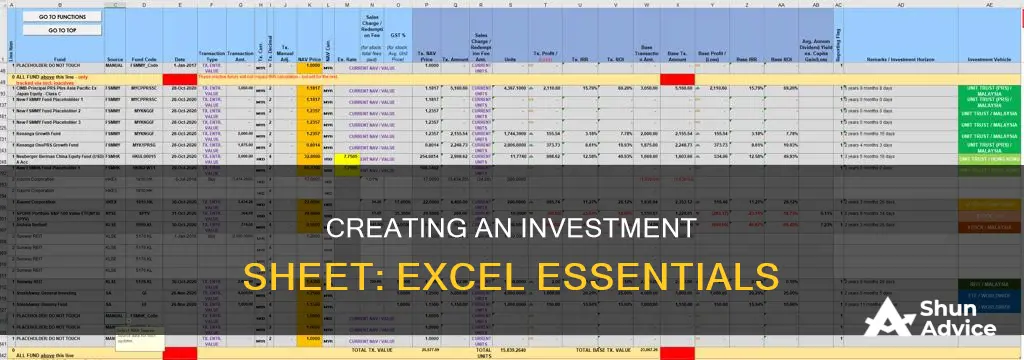
Keeping track of your investments is crucial, and Microsoft Excel is a powerful tool to help you do just that. With Excel, you can create a comprehensive investment sheet to monitor your portfolio's performance, calculate future outcomes, and assess risk, profit, and loss. In this paragraph, we will explore the benefits of using Excel for investment tracking, including its ability to provide real-time data, perform complex calculations, and offer a structured approach to portfolio management. We will also guide you through the initial steps of setting up your investment sheet, from inserting stocks into Excel to generating relevant information and adding your investment details. So, whether you're a seasoned investor or just starting, Excel can be a valuable tool to help you make informed decisions and stay on top of your investment game.
| Characteristics | Values |
|---|---|
| Purpose | Track and manage investment portfolio |
| Tools | Microsoft Excel, Google Sheets |
| Data | Stock names, traded names, ticker symbols, number of shares, purchase price, current price, quantity, closing prices, difference between closing and entry price, percentage return, profit and loss, standard deviation |
| Functions | STOCKHISTORY, STDEV |
| Benefits | Automate current and historic stock pricing data, calculate metrics (e.g. standard deviation, percentage return, profit and loss), visualise data through charts and diagrams, identify trends, make informed decisions |
| Limitations | Requires manual calculation for some values, limited in terms of dividend information |
What You'll Learn

Inserting stocks into Excel
To insert stocks into an Excel spreadsheet, you will first need to open a new spreadsheet and create cells that contain your ticker symbol, company name, or fund name. You can also include the number of shares, the current price, the difference between the current price and the entry price, the percentage return, profit and loss, and the overall standard deviation.
While it is not required, it is recommended that you create a table with your data so that you can add more columns with stock information. To do this, highlight your new cells and select Insert > Table. Make sure your ticker symbols are still selected, then head to the Data tab and click on Stocks. You will now have a linked stock table with a little stock icon.
Now you can add columns of various data. Click on a stock name, and you will see the option to add a column with various types of data. You can then build out whatever columns you want, such as price, change in price, last trade time, previous close, and exchange.
If you want to insert a stock price into Excel, you can convert text into the Stocks data type. Then, you can use another column to extract certain details relative to that data type, like the stock price, change in price, etc. You can also write formulas that reference data types or use the STOCKHISTORY function.
Understanding Alpha: Investment Management Secrets Revealed
You may want to see also

Convert data into stocks
To convert data into stocks in Excel, you must first ensure that you have the correct account and language settings. The Stocks data type is only available to Microsoft 365 accounts or those with a free Microsoft Account, with the editing language in Office Language Preferences set to English, French, German, Italian, Spanish, or Portuguese.
Once you have confirmed your account and language settings, you can begin to convert data into stocks. Start by opening your spreadsheet and typing a piece of information related to the stock you want to add, such as the company name or stock symbol, into a cell. With the cell still selected, open the "Data" tab and then click "Stocks" in the "Data Types" section of the ribbon.
After a few seconds, depending on your internet connection, the "Data Selector" sidebar may open on the right if Excel cannot find your item or if there is more than one stock with the same name. Click "Select" under any of the available options in the sidebar. If you click away from the cell, simply select it again and then click the "Insert Data" icon.
A long list of stock market details will appear, from which you can choose the information you want to include in your spreadsheet. Any additional details you choose will populate the subsequent cells to the right. You can also add column headers to identify the data included.
To view the data in a card format, right-click the cell containing the company or stock name and select "Show Data Type Card" from the menu. This will display the data in an easy-to-read snapshot, which you can enlarge if necessary. To add more information from the card to your sheet, hover your cursor over the data and click the "Extract to Grid" icon.
You can also write formulas that reference the data types or use the STOCKHISTORY function to retrieve historical financial data.
Investing in Tesla: A Guide for Indians
You may want to see also

Generate relevant information
Once you have inserted the stocks into Excel and converted the data into stocks, it's time to generate relevant information. This is where you can leverage the power of Excel to create a comprehensive investment portfolio.
Click on any cell that contains a stock name in your portfolio. An icon will appear, and once you click on it, a drop-down list will be displayed. From this list, you can select the information you want to generate, such as stock price, market cap, and percentage change. Excel offers built-in tools that automatically calculate stock information, making it easier for you to track your investments.
You can also add your own formulas to compute more advanced metrics. For example, you can calculate the difference between an asset's current price and its entry price by using the formula "= (current price - entry price)". This will help you determine the profit or loss on your investments.
Additionally, you can include other data points such as the number of shares you own, the total value of your holdings, and the percentage of your portfolio that each stock represents. This will give you a more detailed overview of your investment portfolio.
By generating relevant information, you can make data-driven decisions, set investment goals, and manage your risk effectively. This step is crucial in creating a dynamic and informative investment sheet in Excel.
Background Checks: Vetting Investment Managers
You may want to see also

Add investment information
Now that you have generated relevant information about your stocks, it's time to add your investment information. This is where you will input the specifics of your investments, such as the number of shares purchased and the amount spent.
Firstly, list the number of shares you have purchased for each stock in your portfolio. For instance, if you bought 100 shares of Apple, 200 shares of Google, and so on, you would enter these numbers in the respective rows.
Next, indicate the initial cost of each stock. In the example above, let's say you spent $150 on Apple shares and $300 on Google shares. Input these values in the corresponding rows.
Now, calculate the worth of your investment in each company. You can do this by multiplying the number of shares (from the previous step) with the initial cost per share. This will give you the total amount invested in each stock.
Then, calculate the current value of your holdings. To do this, multiply the number of shares you own by the current market price of each stock. This will give you an up-to-date value of your investments.
You can also add another column to indicate whether you are making a gain or loss on each stock. To do this, subtract the initial investment amount from the current value of each investment. If the result is positive, it represents a gain; if it is negative, it indicates a loss. You can use conditional formatting to visually highlight the gain/loss values, making them easier to interpret at a glance.
Additionally, you may want to include a column for your target price, which will show how close or far you are from your desired price as a percentage. This can help you determine if it is the right time to buy more shares or consider selling.
Visual aids, such as charts and diagrams, can also be incorporated to help you understand the composition of your investment portfolio and the factors driving your overall returns.
Remember to include aggregate totals for your initial investments, current values, and overall returns at the bottom of your spreadsheet for a quick summary.
Depending on your trading style and volume, you can customize your Excel sheet to suit your needs. For instance, if you receive dividend payments from your stocks, you can add this information to your portfolio by manually checking the yearly yield of each stock and creating a table for the amounts received.
If you are dealing with a large number of stocks from different industries, you may also want to use filters to easily identify which industries are performing better or worse, helping you make more informed investment decisions.
By following these steps, you will have a comprehensive investment information section in your Excel sheet, allowing you to track your investments, visualize your capital, and make data-driven choices.
Understanding Active Management Fees: Strategies and Costs
You may want to see also

Add analysis formulas
Once you have inserted the stocks into Excel, converted the data, generated relevant information, and added your investment information, it is time to add your analysis formulas.
Firstly, add another column that indicates if you are gaining or losing on each stock that you hold. You can set conditional formatting to visually see the value of the gain/loss. Calculate this new column by subtracting the initial investment from the current value of each investment.
Additionally, you can add a column that determines your target price to see how close or far you are from your target price in terms of percentage. You can also insert charts and diagrams to understand the distribution of your investment portfolio and what makes up your overall returns.
Note that you should also add the aggregate totals of your initial investments, the current values of your investments, and the overall returns that you realize in your portfolio.
Excel can also be used to calculate the break-even point of a stock, which is the price a stock needs to achieve to ensure a net income of zero. Anything beyond that is pure profit. Here is a formula that can be used to calculate the break-even point:
= (((Buying Price*Shares Purchased+(Commission*2))/Shares Purchased)-Tax Rate*Buying Price)/(1-Tax Rate)
For an accurate prediction of profit, you will need to consider the following categories:
- Buying price: How much you paid for a stock per share
- Shares purchased: The number of shares of a stock that you own
- Commission: What you will pay a brokerage service to buy or sell a stock
- Tax rate: Depending on the length of the investment, you will need the figure for a long-term capital gains rate if you hold onto your stock for the long run, or a federal tax bracket if you sell before the end of the year
- State income tax rate: An optional value that varies state by state
These will be listed as additional columns in your investment tracking spreadsheet.
Strategic Equity Investments: Balance Sheet Reporting
You may want to see also
Frequently asked questions
Excel is a versatile tool for investment tracking, allowing you to monitor your portfolio's performance, calculate future projections, assess risk, profit and loss, and compare different investments. It offers automated calculations and real-time data integration, making it a powerful tool for informed decision-making.
First, list the stocks you own or plan to purchase. You can use company names, traded names, or ticker symbols. Next, convert the company names into stocks by selecting the data and choosing 'Stocks' from the Data menu. This will generate relevant stock information. You can then customize your spreadsheet by adding columns for investment details, shares, prices, and other metrics.
Excel offers various formulas to calculate metrics such as difference, percent return, profit/loss, and standard deviation. To calculate the difference between an asset's current and entry price, use the formula: =(current price – entry price). For percent return: =((price – entry) / entry). For profit and loss: =(difference x number of shares). Standard deviation can be calculated using the STDEV function.
Utilize the real-time stock data updating feature in Excel to make informed decisions based on current market trends. Use the Watchlist tab to monitor potential investment opportunities and track securities you're considering for future investments. This helps you stay proactive and seize opportunities as they arise.







